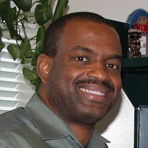
SDO Flight Software Product Development Lead
Undergrad: B.S. in Electrical Engineering, Hofstra University
Masters: Masters in Computer Science, George Washington University
WHAT DO YOU DO AS AN SDO FLIGHT SOFTWARE PRODUCT DEVELOPMENT LEAD?
I'm responsible for all that pertains to the SDO Flight Software (FSW) and its delivery to the SDO Spacecraft. I'm responsible for leading a team of approximately 28 engineers in the development and testing of the SDO Flight Software. This involves managing the cost and schedule, developing the actual Flight Code, planning the deployment of the code, allocating resources, collaborating with other subsystems to ascertain and document their FSW needs, developing diagnostic FSW to test Hardware boxes, as well as ensuring that adequate resources are available to maintain the Flight Software after SDO launch. Additionally, I'm responsible for delivering a portion of the Flight Software for the EVE instrument.
WHAT DO YOU LIKE MOST ABOUT YOUR JOB?
I like my job because it is challenging and there is always something interesting to do. The people I work with are extremely talented, and I really enjoy being able to solve problems in a collaborative fashion. Most importantly, I really enjoy being involved in developing solutions to complex problems.
WHEN DID YOU DECIDE YOU WANTED TO WORK FOR NASA?
When I was young I wanted to be a doctor. In High School I still wanted to do medicine, however, I saw my brother fix a television, and thought that was "way cool", and instantly switched my thoughts to electronics. After college, I interviewed with Motorola, Microsoft, AT&T, and NASA. My dad, an astronomy buff, and I were just overwhelmed with joy at the prospect of actually working for the Space Agency. After my interview with the NASA representative in Florida, I sat on pins and needles waiting for the response. Finally, the answer came, I packed my bags, left New York and the rest is, as they say, "history".
WHERE DID YOU GO TO SCHOOL AND WHAT DEGREES DID YOU GET?
After High School, I attended Technical Careers Institute, in Windsor CT., where I graduated with a Certificate as an Electronic Technician. Three years later, I attended Hofstra University, in Hempstead, NY where I graduated with a Bachelor of Science degree in Electrical Engineering. After I began my career here at Goddard, I enrolled at The George Washington University, in Washington, DC, where I graduated with a Master of Science in Computer Science.
WHAT WAS THE FIRST JOB YOU EVER HAD?
I was as a paperboy! However, I've worked on jobs ranging from working in the Sugar plants, to fixing video games in an arcade (I've also worked as a secretary in a small but busy office too).
HOW DID YOU COME TO ACTUALLY WORK FOR NASA?
I interviewed for a position at NASA at a Job fair in Florida.
HOW LONG HAVE YOU BEEN WORKING FOR NASA?
I first came to work here on June 18, 1990, so I guess that makes it about 17 years and two months. (Time flies...)